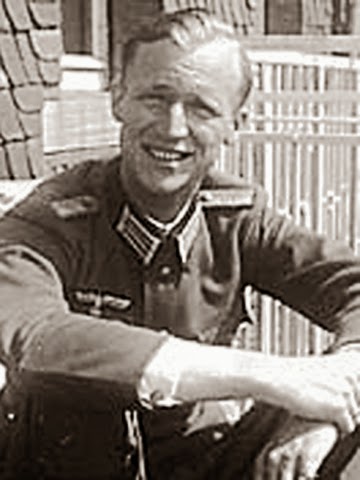Major Axel Baron von dem Bussche-Streithorst
On 5 October 1942, when he was 23 years old, Axel von dem Bussche-Streithorst found himself at Dubno airfield in the Ukraine. By chance, he witnessed the mass shooting of five thousand Jews.
He saw
everything. The Ukrainian SS, in calm, orderly fashion, compelled Jews –
including many women and children – to dig a pit, strip in the snow and lie
face-down in the pit. The SS shot them. More Jews were compelled to strip and
lie on the freshly killed or still-writhing bodies of those in the pit. They,
too, were shot in the back of the head or the nape of the neck.
Bussche was
no fool. He knew what he was seeing. These SS men were acting under orders. The
initiative for mass murder of the Jews must have come from the government – to
which he had sworn allegiance.
He
considered personally ordering the slaughter to stop by invoking emergency
paragraph 227 of the criminal law – the right to defend others against unlawful
attack. Not only did he, as a Wehrmacht officer, have no jurisdiction to give
orders to the SS, but even if the SS had taken any notice of him, the ‘special
treatment’ would have gone on next day.
He later
thought he should have stripped off his own clothes and joined the Jews by
lying down in the death pit.
Bussche was
traumatised by this experience. He was determined to do anything in his power
to remove Hitler and his regime.
In October
1943, Claus von Stauffenberg asked Bussche whether he was prepared to attempt to assassinate
Hitler. Bussche said he was. They briefly discussed using a pistol, and then
agreed it was too risky. Only one shot could probably be counted on, and even
at short range the chance of this killing the target was uncertain.
Claus then
raised the possibility of Bussche conducting the demonstration of new uniforms
for Hitler, fusing a bomb, and clasping the Führer in a death embrace. After
all, Bussche was an ideal candidate for demonstrating uniforms. He looked very
‘Aryan’, he had fought all across the eastern front from Leningrad to the
Crimea, and was highly decorated for bravery.
Bussche
agreed.
He conferred
with several officers as to the best means and equipment for the task. General Stieff arranged for a one-kilogram charge used for bridge demolition to be
delivered to Bussche. He wanted a four-and-a-half-second hand-grenade fuse. Although
it hissed, he thought he could cover the sound by clearing his throat and
coughing.
For soldiers
a long way from the front, obtaining grenades was no simple matter. When the
grenades were to hand Bussche modified the fuse to allow a simple movement to
set it off. The initial plan was to strap the explosives to his body, but he
found he could conceal it all in one of the capacious pockets of his wide army
trousers.
Bussche had
a back-up plan – he secreted a long thin knife in the sole of his boot.
All was
ready. The conspirators waited for Hitler to carry out the uniforms inspection.
Hitler did not give advance notice of his movements, but his aides provided an
approximate date. The conspirators were given a ‘preliminary warning’.
From 23 to
25 November 1943 Bussche held himself in readiness for the assassination.
Finally, he received a summons to see General Stieff. Bussche expected the
final details of the uniform inspection, but instead Stieff informed him that
Allied bombs had destroyed the uniforms Hitler was to have inspected. Until
fresh uniforms could be made, Bussche should return to his unit on the eastern
front.
In January
1944, Claus rang Bussche to have him return for the rescheduled inspection.
Bussche sought the necessary permission from his commanding officer – who was
not party to the conspiracy. The general was not prepared to have a key officer
leave the front to model uniforms. Claus rang the commanding officer to intercede.
The general would not relent.
A few days
later, Bussche was severely wounded and lost a leg. He was hospitalised for
months. The conspirators had to look elsewhere. Bussche carried the small box
containing his bomb from hospital to hospital until he eventually threw it into
a lake after Claus’s attempt later that year.
His injuries put Bussche out of the resistance and the war.
In post-war Germany Bussche qualified as a lawyer. He married Camilla von Stauffenberg (previously married to a cousin of Claus's). He worked for the BBC for a time before he became a diplomat and then a headmaster. He was involved in the evangelical church in Germany, and the World Bank.
When he died in 1993, his best friend was Richard von Weizsäcker, president of Germany.
Edited extract from TREASON: Claus von Stauffenberg and the Plot to Kill Hitler


